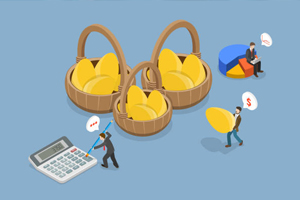Impact of inflation on investment returns
Explore the intricate dynamics of inflation and investment returns in our comprehensive guide Gain expert insights, proactive strategies, and real-world examples to fortify your portfolio against the impact of inflation Stay informed, make informed decisions, and enhance the resilience of your investments
Welcome to an insightful exploration of the intricate relationship between inflation and investment returns. In today's dynamic economic landscape, understanding the impact of inflation on investment portfolios is paramount for investors seeking to navigate the challenges and seize opportunities in the financial markets.
This comprehensive guide delves into the basics of inflation, providing a nuanced understanding of its evolution over time and its implications for investment planning. Expert insights from seasoned professionals shed light on proactive strategies, risk management approaches, and the role of central banks in shaping the landscape affected by inflationary pressures.
From exploring the erosion of real returns to deciphering the significance of diversification and inflation-protected securities, this resource aims to equip investors with the knowledge needed to construct resilient portfolios. Real-world examples and case studies offer practical perspectives on how different investments respond to inflation, providing valuable lessons for both seasoned investors and those new to the financial arena.
As we navigate through expert insights, case studies, and FAQs, we invite you to embark on a journey that goes beyond the theoretical, offering actionable insights to fortify your investment strategies against the challenges posed by inflation. The guide is designed to empower you to make informed decisions, adapt to changing economic conditions, and ultimately enhance the longevity and robustness of your investment endeavors.

The Impact of Inflation on Investment Returns
The Basics of Inflation
Explore the fundamental concepts of inflation, explaining its definition, causes, and how it is measured. Discuss key economic indicators associated with inflation, such as the Consumer Price Index (CPI) and the Producer Price Index (PPI).
Understanding the Relationship Between Inflation and Investments
Examine the intricate connection between inflation and various investment types. Delve into how inflation affects the purchasing power of money and why understanding this relationship is crucial for investors.
How Inflation Erodes Real Returns
Detail the mechanisms through which inflation erodes the real returns of investments. Discuss the concept of nominal vs. real returns, highlighting how inflation diminishes the actual purchasing power and value of investment gains.
Strategies to Hedge Against Inflation
Provide an in-depth exploration of strategies investors can employ to hedge against the negative impact of inflation. This may include diversification, investing in inflation-protected securities, and considering real assets like real estate and commodities.
Investment Vehicles Resilient to Inflation
Highlight specific investment vehicles known for their resilience to inflation. Explore options such as Treasury Inflation-Protected Securities (TIPS), inflation-indexed bonds, and certain equities that historically have demonstrated the ability to outperform during inflationary periods.
Long-Term Effects: Inflation's Impact on Retirement Savings
Examine the long-term implications of inflation on retirement savings. Discuss how inflation can impact the purchasing power of retirement income, emphasizing the importance of considering inflation when planning for retirement.
Real-World Examples of Inflation's Influence on Investments
Illustrate the theoretical concepts with real-world examples. Analyze historical instances where inflation significantly affected different asset classes and share insights on lessons learned from those scenarios.
Expert Insights on Inflation and Investment Planning
Curate insights from financial experts and economists regarding inflation's role in investment planning. Include expert opinions on adapting investment strategies to mitigate the effects of inflation and capitalize on potential opportunities.
Addressing Common Concerns: FAQs on Inflation and Investment
Answer frequently asked questions related to the impact of inflation on investment returns. Cover concerns such as how inflation rates are forecasted, the role of central banks, and practical tips for investors to navigate inflationary environments.
The Basics of Inflation
Definition of Inflation
Provide a clear and concise definition of inflation, explaining it as the sustained increase in the general price level of goods and services in an economy over a period of time. Offer examples to illustrate how inflation impacts the cost of living for consumers.
Causes of Inflation
Explore the various factors that contribute to inflation. Discuss demand-pull inflation, cost-push inflation, and built-in inflation, offering real-world examples to help readers understand the dynamics behind each cause.
Measurement of Inflation
Detail the common methods used to measure inflation, with a focus on indices such as the Consumer Price Index (CPI) and the Producer Price Index (PPI). Explain how these indices track changes in the prices of goods and services over time.
Types of Inflation
Discuss the different types of inflation, including moderate inflation, hyperinflation, and deflation. Explain the potential consequences of each type and provide historical examples to illustrate their impact on economies.
Inflation vs. Deflation
Draw a comparison between inflation and deflation, highlighting the key differences and similarities. Explore the potential effects of deflation on investment returns and economic growth, emphasizing the importance of a balanced inflation rate.
Central Bank's Role in Controlling Inflation
Explain the role of central banks, such as the Federal Reserve, in controlling inflation. Discuss how central banks use monetary policy tools like interest rates to influence inflation rates and maintain economic stability.
Inflation's Impact on Purchasing Power
Delve into the concept of purchasing power and how inflation affects the real value of money. Provide examples to illustrate how the purchasing power of a currency decreases over time as prices rise, impacting consumers' ability to buy goods and services.
Global Perspectives on Inflation
Offer a global perspective on inflation, exploring how different countries may experience varying inflation rates. Discuss the factors that contribute to regional differences in inflation and how global economic events can influence inflationary trends.
Inflation Expectations
Explore the concept of inflation expectations and their impact on economic behavior. Discuss how businesses, consumers, and investors form expectations about future inflation rates, influencing their decisions and strategies.
Inflation and Interest Rates
Examine the relationship between inflation and interest rates. Discuss how central banks may adjust interest rates in response to inflationary pressures, affecting borrowing costs, investment decisions, and overall economic activity.
Understanding the Relationship Between Inflation and Investments
Impact of Inflation on Investment Returns
Examine how inflation directly affects investment returns by eroding the real purchasing power of returns. Discuss the importance of considering inflation when assessing the true value and performance of investment portfolios over time.
Asset Class Sensitivity to Inflation
Explore how different asset classes respond to inflationary pressures. Discuss the sensitivity of stocks, bonds, real estate, and commodities to inflation and how investors can strategically allocate their portfolios to mitigate the impact of rising prices.
Inflation-Adjusted Returns
Introduce the concept of inflation-adjusted returns, emphasizing the need for investors to focus on real returns rather than nominal returns. Provide examples of how to calculate and interpret inflation-adjusted returns to make more informed investment decisions.
Risks and Opportunities During Inflationary Periods
Discuss the risks and opportunities that arise for investors during periods of inflation. Explore how inflation can create challenges such as increased interest rates and market volatility, but also present opportunities in certain sectors and asset classes.
Strategies for Inflation-Resilient Portfolios
Provide a comprehensive breakdown of strategies investors can employ to build inflation-resilient portfolios. Discuss diversification, investing in inflation-protected securities, holding real assets, and other tactics to safeguard investments during inflationary environments.
Role of Central Bank Policies
Examine the role of central bank policies in influencing the relationship between inflation and investments. Discuss how central banks may respond to inflationary pressures through monetary policy decisions, impacting interest rates and the broader investment landscape.
Inflation and Fixed-Income Investments
Focus specifically on how inflation affects fixed-income investments such as bonds. Discuss the challenges bond investors face during inflationary periods and explore strategies, such as investing in inflation-indexed bonds, to mitigate these challenges.
Historical Perspectives on Inflation and Investments
Provide historical perspectives on how different investment assets have performed during periods of varying inflation rates. Analyze case studies and lessons learned from past inflationary environments to guide investors in navigating future uncertainties.
Considerations for Long-Term Investors
Address considerations for long-term investors in the context of inflation. Discuss the importance of adjusting investment strategies based on long-term inflation expectations and the potential impact on retirement savings and financial goals.
Expert Insights: Balancing Inflation Risk
Curate insights from financial experts and investment professionals on effectively balancing inflation risk in investment portfolios. Include expert opinions on strategic asset allocation, risk management, and adapting investment strategies in response to changing inflationary conditions.
How Inflation Erodes Real Returns
Nominal vs. Real Returns
Define nominal and real returns, emphasizing the distinction between the two concepts. Explain how nominal returns represent the actual percentage gain or loss on an investment, while real returns adjust for the impact of inflation, providing a more accurate measure of purchasing power.
The Purchasing Power Paradox
Explore the paradox of purchasing power and how inflation erodes the real value of money over time. Provide relatable examples to illustrate how individuals may experience a reduction in their ability to purchase goods and services despite seeing nominal gains in their investments.
Calculating Real Returns
Guide readers through the process of calculating real returns, showcasing formulas and practical examples. Highlight the importance of factoring in the inflation rate to obtain a more realistic assessment of an investment's performance.
Impact on Savings and Investments
Discuss the broader impact of inflation on both savings and various types of investments. Explore how inflation diminishes the future purchasing power of savings accounts, bonds, and other fixed-income investments, leading to potential losses in real terms.
Inflation's Effect on Investment Portfolios
Examine how inflation affects the overall composition and performance of investment portfolios. Discuss the challenges investors face in preserving the real value of their portfolios during inflationary periods and strategies to counteract these effects.
Behavioral Economics and Inflation Perception
Introduce the concept of behavioral economics in the context of inflation perception. Explore how individuals may underestimate the impact of inflation on their investments due to cognitive biases, emphasizing the importance of informed decision-making.
Inflation Risk Assessment
Guide readers in assessing and managing inflation risk within their investment strategies. Discuss the importance of conducting regular risk assessments, considering inflation expectations, and adjusting portfolios accordingly to maintain real returns.
Real-World Examples of Inflation's Erosion
Provide real-world examples and case studies demonstrating how inflation has historically eroded real returns in different economic environments. Analyze specific scenarios to offer practical insights for investors navigating today's complex financial landscape.
Long-Term Investing and Inflation Mitigation
Discuss the role of long-term investing as a strategy to mitigate the impact of inflation. Highlight how a patient and disciplined investment approach can help investors ride out short-term fluctuations and preserve real wealth over extended periods.
Expert Strategies: Guarding Against Inflation Erosion
Curate expert strategies and insights on effectively guarding against the erosion of real returns caused by inflation. Include perspectives from financial analysts and investment professionals, offering actionable advice for investors looking to navigate the challenges of inflation.
Strategies to Hedge Against Inflation
Diversification Across Asset Classes
Explain the importance of diversification as a fundamental strategy to hedge against inflation. Discuss how spreading investments across various asset classes, including stocks, bonds, real estate, and commodities, can help balance the impact of inflation on a portfolio.
Inflation-Protected Securities (TIPS)
Provide an in-depth look at Inflation-Protected Securities (TIPS) as a specific investment option to guard against inflation. Explain how TIPS adjust their principal value with changes in the Consumer Price Index (CPI), offering investors a way to preserve purchasing power.
Real Assets: Real Estate and Commodities
Explore the role of real assets, such as real estate and commodities, in inflation hedging. Discuss how these tangible assets often exhibit positive correlations with inflation, making them potential stores of value during inflationary periods.
Equity Investments in Inflation-Resilient Sectors
Examine specific equity sectors known for their resilience to inflation. Highlight sectors such as utilities, consumer staples, and natural resources, which may perform well during inflationary periods, providing investors with stability and potential growth.
Variable and Floating-Rate Investments
Discuss the benefits of incorporating variable and floating-rate investments into a portfolio to navigate changing interest rates associated with inflation. Explore securities such as floating-rate bonds and adjustable-rate mortgages as potential hedges.
Foreign Currency and International Investments
Explore the role of foreign currency and international investments in diversifying against domestic inflation risks. Discuss how exposure to different currencies and international markets can provide additional layers of protection in a globally interconnected economy.
Short-Term Investments and Liquidity
Highlight the significance of maintaining liquidity and holding short-term investments as part of an inflation hedging strategy. Discuss how cash equivalents and short-duration securities can provide flexibility to seize opportunities and navigate market uncertainties.
Investing in Dividend-Paying Stocks
Examine the potential benefits of investing in dividend-paying stocks as a source of income and a hedge against inflation. Discuss how companies with a history of consistent dividend payments may provide a reliable income stream that can keep pace with rising prices.
Adapting Investment Strategies to Inflation Expectations
Guide investors on the importance of adapting their investment strategies based on inflation expectations. Discuss how staying informed about economic indicators, central bank policies, and market conditions can help investors make proactive adjustments to their portfolios.
Professional Guidance: Consultation with Financial Advisors
Emphasize the role of seeking professional guidance from financial advisors when implementing inflation hedging strategies. Discuss how advisors can tailor strategies to individual risk tolerances, financial goals, and the prevailing economic environment.
Investment Vehicles Resilient to Inflation
Treasury Inflation-Protected Securities (TIPS)
Provide an in-depth analysis of Treasury Inflation-Protected Securities (TIPS) as a government-backed investment option designed to protect against inflation. Explain how TIPS adjust their principal value with changes in the Consumer Price Index (CPI), making them a reliable inflation hedge.
Real Estate Investment Trusts (REITs)
Explore the role of Real Estate Investment Trusts (REITs) as investment vehicles resilient to inflation. Discuss how REITs, which own and manage income-generating real estate, may provide a hedge against rising prices and offer investors exposure to the real estate market.
Commodity-Linked Investments
Examine investments linked to commodities as a strategy to navigate inflationary pressures. Discuss the potential benefits of commodity futures, commodity-focused exchange-traded funds (ETFs), and direct investments in commodities for diversification and inflation protection.
Infrastructure and Natural Resource Funds
Discuss the resilience of infrastructure and natural resource funds in the face of inflation. Explore how investing in funds that focus on essential infrastructure projects and natural resources can provide a hedge, as these assets often have intrinsic value that can withstand inflationary trends.
Dividend-Paying Stocks with Consistent Growth
Highlight the significance of dividend-paying stocks with a track record of consistent growth as investment vehicles resilient to inflation. Discuss how companies with a history of increasing dividends may provide investors with a reliable income stream that has the potential to outpace inflation.
Inflation-Indexed Bonds Beyond TIPS
Expand on the universe of inflation-indexed bonds beyond TIPS, exploring other government and corporate bonds designed to protect against inflation. Discuss the advantages and considerations of investing in bonds with inflation-linked features beyond those offered by the U.S. Treasury.
Gold and Precious Metals
Explore the role of gold and precious metals in constructing a portfolio resilient to inflation. Discuss how these assets have historically been considered safe havens during times of economic uncertainty and inflation, serving as a store of value and a hedge against currency depreciation.
Energy Sector Investments
Examine investments in the energy sector as a potential hedge against inflation. Discuss how energy companies, especially those involved in the production and distribution of essential resources, may benefit from rising prices and provide stability in an inflationary environment.
Strategic Allocation Strategies
Discuss strategic allocation strategies that investors can employ to build portfolios resilient to inflation. Explore the concept of dynamic asset allocation, where investors regularly reassess their portfolio composition based on prevailing economic conditions, including inflation expectations.
Inflation-Responsive ETFs
Highlight the emergence of inflation-responsive Exchange-Traded Funds (ETFs) as investment vehicles designed to adapt to changing inflation dynamics. Discuss how these ETFs may employ various strategies, such as investing in inflation-protected bonds or inflation-sensitive sectors, to provide investors with targeted exposure.
Professional Advice: Consulting Financial Planners
Emphasize the importance of seeking professional advice from financial planners when considering investment vehicles resilient to inflation. Discuss how financial planners can assess individual risk tolerance, financial goals, and market conditions to tailor strategies that align with investors' unique circumstances.
Long-Term Effects: Inflation's Impact on Retirement Savings
Inflation's Erosion of Purchasing Power Over Time
Explore how inflation gradually erodes the purchasing power of retirement savings over an extended period. Discuss the compounding effect of inflation on the real value of money, emphasizing the importance of accounting for inflation in retirement planning.
Challenges Faced by Fixed-Income Investments
Discuss the challenges posed by inflation to fixed-income investments commonly held in retirement portfolios. Explore how bonds and other fixed-income securities may face a decline in real returns, impacting the ability of retirees to maintain their desired lifestyle.
Strategies for Building an Inflation-Resilient Retirement Portfolio
Provide a comprehensive breakdown of strategies for building a retirement portfolio that can withstand the impact of inflation. Discuss the importance of diversification, incorporating inflation-protected assets, and regularly reassessing the portfolio to adapt to changing economic conditions.
Incorporating Inflation-Indexed Annuities
Examine the role of inflation-indexed annuities in retirement planning. Discuss how these financial products, which adjust payouts based on inflation, can provide retirees with a degree of protection against the rising cost of living throughout their retirement years.
The Impact of Social Security Adjustments
Explore how Social Security benefits, while providing a degree of inflation protection through cost-of-living adjustments (COLAs), may not fully offset the impact of rising prices. Discuss the need for supplementary retirement savings to enhance financial security.
Real-Life Retirement Scenarios and Inflation
Present real-life retirement scenarios to illustrate the potential challenges posed by inflation. Discuss how individuals may need to adapt their retirement lifestyles or implement additional strategies to mitigate the long-term effects of inflation on their savings.
Retirement Withdrawal Strategies in an Inflationary Environment
Discuss various retirement withdrawal strategies that can help retirees navigate an inflationary environment. Explore concepts such as the 4% rule, dynamic withdrawal strategies, and the importance of maintaining flexibility in spending patterns to accommodate changing economic conditions.
Government Policies and Inflation Risk
Examine the potential impact of government policies on inflation risk in retirement. Discuss how economic policies, interest rates, and fiscal decisions may influence the inflationary environment, and advise retirees on staying informed and adapting their strategies accordingly.
The Role of Long-Term Investments in Retirement
Highlight the significance of long-term investments in retirement planning as a means to combat the long-term effects of inflation. Discuss the benefits of maintaining a balanced and diversified portfolio with a focus on assets that historically provide growth over extended periods.
Professional Guidance: Working with Retirement Planners
Emphasize the importance of seeking professional guidance from retirement planners to address the long-term effects of inflation. Discuss how retirement planners can assist individuals in creating personalized strategies that align with their financial goals, risk tolerance, and the potential challenges posed by inflation.
Real-World Examples of Inflation's Influence on Investments
Case Study 1: Impact on Fixed-Income Investments
Examine a real-world case study showcasing the impact of inflation on fixed-income investments. Discuss how bond portfolios may experience diminishing purchasing power over time, leading investors to reassess their fixed-income strategies in the face of inflationary pressures.
Case Study 2: Diversification Strategies Amid Inflation
Explore a case study highlighting the effectiveness of diversification strategies amid inflation. Discuss how a well-diversified portfolio, including inflation-protected assets, equities, and alternative investments, can mitigate the negative effects of inflation on overall investment returns.
Case Study 3: Retirement Planning in an Inflationary Environment
Present a case study focusing on the challenges and solutions associated with retirement planning in an inflationary environment. Discuss how retirees can adjust their withdrawal strategies, incorporate inflation-protected annuities, and diversify their portfolios to address the long-term impact of rising prices.
Case Study 4: Government Policies and Investment Outcomes
Examine a case study illustrating the influence of government policies on investment outcomes during inflationary periods. Discuss how changes in fiscal and monetary policies can impact asset values and investment returns, providing insights into how investors can adapt their strategies accordingly.
Case Study 5: Historical Examples of Inflation-Resilient Investments
Explore historical examples of investments that have demonstrated resilience to inflation. Discuss how certain asset classes, industries, or specific investments have weathered past inflationary periods, offering valuable lessons for contemporary investors seeking to build inflation-resistant portfolios.
Case Study 6: Inflation's Impact on Different Asset Classes
Analyze a case study that delves into how inflation affects various asset classes differently. Discuss the contrasting performance of equities, real estate, commodities, and other investments during inflationary episodes, providing investors with insights into constructing balanced portfolios.
Case Study 7: Dynamic Strategies for Inflation-Responsive Portfolios
Present a case study showcasing dynamic strategies for managing inflation-responsive portfolios. Discuss how investors can actively adjust their asset allocations, explore alternative investments, and stay informed about economic indicators to navigate changing inflationary environments effectively.
Case Study 8: Long-Term Effects on Retirement Income Streams
Examine the long-term effects of inflation on retirement income streams through a case study. Discuss scenarios where retirees face challenges in maintaining their desired lifestyle due to the erosion of purchasing power and explore strategies to counteract these effects through thoughtful retirement planning.
Case Study 9: The Role of Technology in Inflation-Resilient Investments
Explore a case study highlighting the role of technology in identifying and capitalizing on inflation-resilient investments. Discuss how advancements in data analytics, machine learning, and financial technology can assist investors in making informed decisions to protect their portfolios in inflationary environments.
Case Study 10: Investor Responses to Inflationary Pressures
Present a case study illustrating how different investors respond to inflationary pressures. Discuss diverse approaches, risk tolerances, and investment philosophies, offering a nuanced perspective on the choices investors make when confronted with the challenges posed by inflation.
Expert Insights on Inflation and Investment Planning
The Evolving Nature of Inflation
Gain insights from financial experts on the evolving nature of inflation. Discuss how inflationary trends have changed over time, exploring historical perspectives and their implications for contemporary investment planning.
Strategies for Identifying Inflationary Signals
Explore expert-recommended strategies for identifying early signals of inflation. Delve into economic indicators, market trends, and geopolitical factors that experts consider crucial for investors to monitor in order to proactively adjust their investment plans in response to potential inflationary pressures.
The Intersection of Inflation and Portfolio Diversification
Receive expert guidance on the intersection of inflation and portfolio diversification. Discuss how financial professionals approach diversification strategies to mitigate the impact of inflation on investment returns, offering practical advice for constructing resilient portfolios.
Inflation-Protected Securities: An Expert Overview
Get an expert overview of inflation-protected securities and their role in investment planning. Explore how instruments like Treasury Inflation-Protected Securities (TIPS) and other inflation-linked bonds can be integrated into portfolios to provide investors with a measure of protection against the eroding effects of inflation.
The Role of Central Banks in Inflation Management
Gain expert insights into the role of central banks in managing inflation and its impact on investments. Discuss how monetary policies, interest rates, and central bank decisions influence inflation dynamics, providing investors with a broader understanding of the macroeconomic factors affecting their portfolios.
Adapting Investment Strategies in an Inflationary Environment
Explore expert perspectives on adapting investment strategies in an inflationary environment. Discuss proactive measures investors can take, such as adjusting asset allocations, exploring alternative investments, and incorporating dynamic strategies to navigate changing economic conditions effectively.
The Impact of Inflation on Specific Asset Classes
Receive expert analysis on how inflation impacts specific asset classes. Explore the nuanced effects on equities, bonds, real estate, commodities, and other investments, providing investors with a comprehensive understanding of how different assets perform in the face of rising prices.
Risk Management and Inflation: Insights from Professionals
Gain insights from risk management professionals on navigating investment risks associated with inflation. Discuss how effective risk management practices can contribute to building resilient portfolios that can withstand the uncertainties brought about by inflationary pressures.
Inflation Scenarios: A Panel Discussion
Participate in a virtual panel discussion featuring experts discussing different inflation scenarios. Explore various hypothetical situations, potential market reactions, and expert opinions on how investors can prepare for and respond to different levels of inflation in the global economy.
Long-Term Investment Perspectives in an Inflationary World
Engage with financial experts sharing long-term investment perspectives in an inflationary world. Discuss the importance of adopting a forward-looking approach to investment planning, considering the potential challenges and opportunities presented by persistent inflation trends.
FAQs on the Impact of Inflation on Investment Returns
Q1: How does inflation affect investment returns?
A: Inflation erodes the purchasing power of money, impacting the real returns of investments. As prices rise, the future value of money decreases, affecting the overall performance of investment portfolios.
Q2: What investment strategies can mitigate the impact of inflation?
A: Diversification, incorporating inflation-protected securities, and adapting to dynamic economic conditions are effective strategies to mitigate the impact of inflation on investment returns. Experts recommend a well-balanced and flexible approach.
Q3: Are there specific investments resilient to inflationary pressures?
A: Certain investments, such as inflation-protected securities (TIPS), real assets like real estate and commodities, and equities with pricing power, are considered resilient to inflation. However, the effectiveness may vary, and a diversified approach is often recommended.
Q4: How can investors identify early signals of inflation?
A: Monitoring economic indicators, market trends, and geopolitical factors are crucial for identifying early signals of inflation. Consulting financial experts and staying informed about macroeconomic developments can assist investors in making informed decisions.
Q5: What role do central banks play in managing inflation and its impact on investments?
A: Central banks influence inflation dynamics through monetary policies and interest rate decisions. Understanding these factors is essential for investors, as central bank actions can significantly impact the performance of investments in an inflationary environment.




























